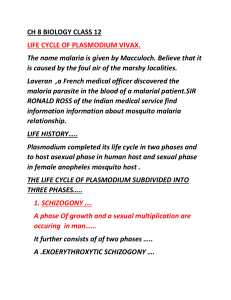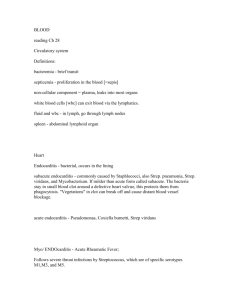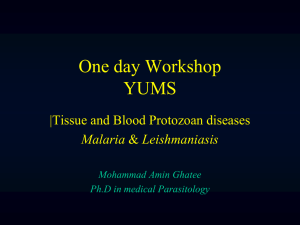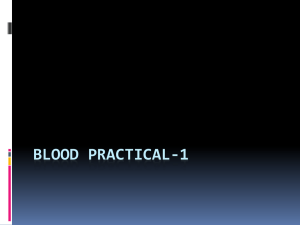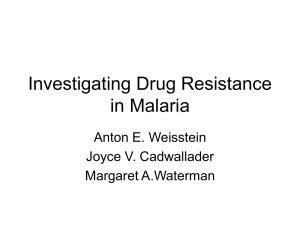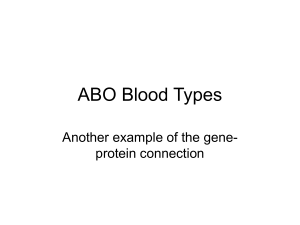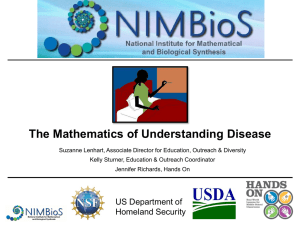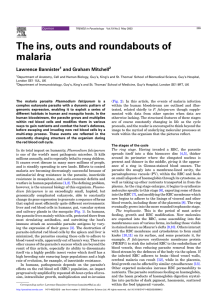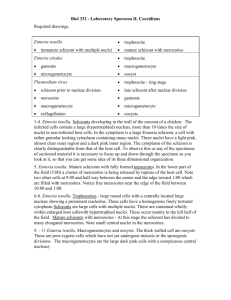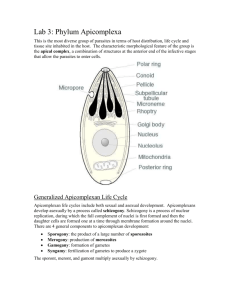11、疟原虫 - 人体寄生虫学
advertisement
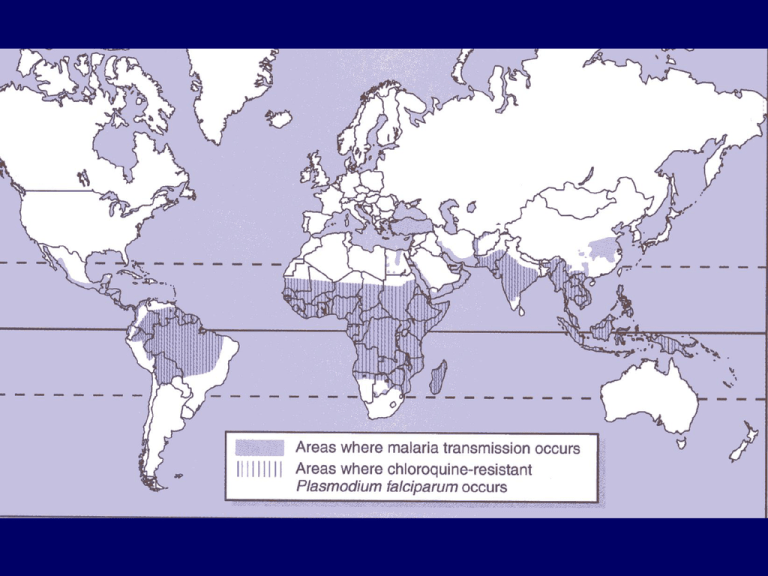
Plasmodium Malaria is the most important of all the tropical diseases in terms of morbidity and mortality. Malaria parasites belong to the genus plasmodium. Four species of malaria parasites infecting human are: Plasmodium falciparum (Pf) malignant tertian malaria confined to some province in South Plasmodium vivax (Pv) benign tertian malaria world-wide distribution Plasmodium malariae (Pm) Quartan malaria sporadic distribution Plasmodium ovala (Po) Ovala malaria confined in some places common in West Africa 形态 P.v P.m P.f 环形体 较大,占Rbc1/3, 同P.v 核一个 小,占Rbc的1/6, 时有两个或两个以 上的虫体Rb中 阿米巴样滋养体 不规则,有伪足、带状或卵圆形 空泡 裂殖体 裂殖子6-12个, 成熟裂殖体有 12-24个裂殖子, 呈菊花样排列 排列不规则 雄配子体 小,圆形,核大 与P.v相似 疏松,核位于中 央 腊肠形,两端钝圆, 核大,疏松位于中 央 雌配子体 大,圆形,核小 与P.v相似 致密,核偏位 新月形,两端尖细, 核小致密,居中 红细胞变化 Rbc胀大,褪色, Rbc大小正常, 色泽正常,变形力 薛氏小点 有齐氏小点 下降,有茂氏小点 Two host are required to complete the life cycle of Plasmodium Human are only the intermediate host in which the asexual phase of parasite occurs, the female anopheline mosquito acts as the definitive host, in which the sexual phase occurs. Intracellular parasites (liver cell, RBC) Obligate parasites, reproduce in alternating sexual and asexual cycle asexual cycle: in man schizogony occurs & beginning of gametocytogenesis sexual cycle: process beginning in man, completing in the mosquito ( gametogony, sporogony) The infection starts with the bite of an infected mosquito, when the sporozoite ( infective form) is inoculated by skin into the blood stream & subsequently invades a hepatocyte. Within the hepatocyte, the parasite undergoes a period of differentiation and multiplication to produce the extra -erythrocytic schizont, contained a few thousand merozoites The merozoite, when released from the hepatocyte, enters the blood stream & invades an erythrocytes to start a periodic phase of differentiation & asexual multiplication leading to the erythrocytic schizonts. This process, known as erythrocytic stage within a period of 36-72 hours depending on the species: Pv, Po—44-48 hrs Pf—36 –48 hrs Pm—72 hro At the end of the schizogonic cycle, the infected erythrocyte rupture, liberating merozoites, which in turn infected new erythrocyte. The products of schizont rupture may stimulate the release of tumor necrosis necrosis factor (TNF) and other cytokines from host, causing malarial paroxysms (primary attack of malaria) At same stage, a proportion of merozoites undergo sexual differentiation forming male and female gametocytes. Gametocytes continues to circulate in the blood stream for some time & if ingested by a mosquito anopheles, undergo transformation to gametes which fertilize to from first a zygote, then an ookinete and final oocyst. The oocyst produces by sporogony thousands of sporozoites which migrate to the salivary gland of the moaquito, where they stay until the next bite, thus completing the cycle. 生活史特点: 1.细胞内寄生,有宿主转换和世代交替的现象。 2.在人体内行裂体增殖及配子生殖的开始,在蚊体内 完成有性生殖。 (一)人体内发育 1.红细胞外期 子孢子(sporozoite)侵入肝细胞 红外裂殖体 红外裂殖子 速发型:短潜伏期 迟发型:长潜伏期发作 复发 部分被巨噬细胞消灭 部分侵入红细胞 红细胞内期 早期滋养体(环形体,ringform) 晚期滋养体(阿米巴形滋养体,amoeboid form) 裂殖体(schizont)早期→成熟→(裂体增殖) 被M吞噬 裂殖子(merozoite) 侵入RBC→ 配子体形成 雄(小)配子体(microgametocyte) 雌(大)配子体(macrogametocyte) 蚊吸入 (二)蚊体内发育 雌配子(染色体减数分裂) 雄配子(4-8 个细丝) 交配→合子→动合子→囊合子→子孢子 oocyst In all of four species, asexual multiplication take place within the liver cells, P.vivax & P. ovale a proportion of the infecting sporozoites enter a resting stage before undergoingasexual multiplication, white order undergo this multiplication without delay. The resting stage of the parasite of know as a hypnozoite. After a period of weeks months or year. Reactivation of the hypnozoite initiates asexual division. The hypnozoite have not been observed in the liver cell, infected by sporozoites of P. falciparum & P. malariae. Relationship between the life cycle & relapse or recrudescence Relapse is a recurrence that taken place after complete initial clearing of the erythrocytic infection & implies reinvasion of the blood stream by merozites from activated hypozoites in liver. Recrudescence is a recurrence of symptoms in a patient whose blood stream infection has previously been at such a low level as not to be clinically demonstrable or cause symptoms. Exoerythrocytic stage Sprozoites inoculated when mosquito sucks bleed Sprozoites circulate with blood stream then invade liver cells where schizont occurs Two kind of sprozoites, one develop rapidly, another one slowly the latter called hypnozoite Rupture of infected cells release thousands of merozoites Sprozoites EE schizont EE merozoites Merozoites penetrate circulating RBC, continued cycles of schizogony within RBC responsible for clinical illness Schizont from hypnozoite develop slowly, released merozoites responsible for the relapse No malarial pigment observed in EE stage Erythrocytic stage Merozoites invade to the RBC, through ring form, growing amoebid form, presegmenting schizont, mature schizont, then penetrate fresh RBC again Merozoites penetrate fresh RBC develop to ring form again or develop in gametocytes Pigment occurs in this stage The proportion of macrogametocyte and microgametocyte have to be 8:1 Mosquito phase of cycle Mosquito infected when sucking blood Gametogenesis gametocytes midgut macrogametocytes macrogamete zygote microgametocytes Zygote ookinete microgamete oocyst sporozoites (salivary gland) 四种疟原虫的发育过程的比较 P.v P.m P.f P.o 红外期迟发型子孢子 有 无 无 有 红外期裂殖体大小 42-60μ 48μ 60μ 70x50μ 红外期裂殖体数目 12000个 15000个 40000个 15400个 红外期(速发型)发育时间 红外期特点 1.来自子孢子 2.在肝细胞无疟色素 3.无症状 红内期发育周期 48h 红内期裂殖子数目 36-48h 48h 12-24 个 (16) 6-12个 8-36个 6-12个 红内期发育场所 外周血液 环、配在外 外周血液 周其他在皮 下脂肪及内 脏毛细管 红内期特点 1.来自红外裂殖子或红内期裂殖子 2.在红细胞内有疟色素 3.有症状 在 蚊 体 内 发 育 成 熟 时 间 10-11d (25℃) 72h 外周血液 16d 12d - 生理 (一) 营养 分解 Hb→珠蛋白+血红素 酶 作用 氨基酸 葡萄糖消耗量比正常大100倍 脂肪类耗量也增加4-5倍 (二)与红细胞的关系 1.对红细胞的选择性 疟色素 提供虫体合成蛋白 P.v侵入幼稚Rbc和网织Rbc 感染度不超过1% P.m侵入衰老的Rbc 感染度小于1/500 P.f对各期Rbc无选择性 感染度达10%以上 2.寄生红细胞的变化 P.v寄生的红细胞可胀大,色泽变淡,并出现薛氏小点 P.f可出现: (1) 小突起出现,使Rbc粘附力增大粘于血管内皮上。 (2) Rbc可塑性下降,不能通过5μ的微血管。 3.裂殖子的释出和侵入红细胞 裂殖体 成熟 裂殖子 活动 红细胞变形 泡状隆起 侵入则分成 附着→入胞→封口三个过程 红细胞胀大 破裂 释出 Physiology Nourishment & metabolism Intake of food through the cytostome hemoglobin hematin + globin hemazoin (malarial pigment) resynthesized parasite protein Aerobic metabolism amount of oxygen consumed by the infected about 100 times larger than that of the normal RBC protein, fat, enzyme required, Relationship with the RBC Pv– invade young RBC Pm—invade old RBC Pf—invade all stages of RBC Change of infected RBC Pv—enlarged, pale, Schuffner’s dots Pf—RBC develop excrescence, so RBC’s sticky & adherence to the capillary in internal organs Rupture of schizont & invasion of merozoite into RBC, the pellicle of merozoite surround by surface coat Invasion of merozoite: Apical end adherence to the RBC’s membrane Deform & invasion of RBC’s membrane Invasion of merozoite into RBC form of parasitophorous vacucle 致病 (一)潜伏期 即从病原体侵入机体到出现症状的时间 短 11-25d P.v 长 6-12m P.m 18-25d P.f 7-27d (二)发作 1. 原因 红内期裂殖体成熟,裂殖子胀破红细胞后疟原虫 代谢产物残余,变性的血红蛋白和红细胞碎片进入血 液, 刺激M产生内源性致热源,作用于下丘脑体温中 枢 引起疟疾发作所需要的最低原虫血症 P.v 10-500/mm3 P.m 140/mm3 P.f 500-1300/mm3 2. 临床表现 周期性发作的冷、热、汗是疟疾的典型症状 但也可因为是初发或重复感染或混合感染而使周期性不明显 (三)贫血 原因:1.大量破坏 2.脾功能亢进 3.免疫反应(自身抗体和免疫复合物形成) 4.骨髓抑制 (四)脾肿大 热带巨脾综合症:巨脾、肝肿大、血IgM升高,抗疟药有效 (五)疟性肾病 由P.m引起多见,可致低蛋白血症、水肿蛋白尿、高血压 (六)黑尿热 恶性疟患者多见, 病人有高热、贫血、腰痛、血红蛋白尿、 衰竭 (七)凶险性疟疾 脑型、胃肠型、厥冷型、出血型等。 机理:机械性阻塞学说:内皮细胞表达粘附受体,增强 内皮细胞的粘附性, 脑微血管阻塞、缺O2、 养料耗竭 (八)再燃和复发 1.再燃(recrudescense) 初发后,由于残存的极少量红内期原虫,在一定条件下, 疟原虫大量增殖或又出现症状的情况,即称再燃。 2.复发(relapse) 急性疟患者在发作数次后或用杀裂殖体药物治疗后,可 以停止发作,血中原虫被彻底肃清,并经血液转种也不 能使受血者发病,经一段时间后,在无重复感染情况下, 出现原虫血症或症状,称复发,为红外期迟发型子孢子 (休眠子)引起。 (九)先天性疟疾和儿童疟疾 先天性疟疾的疟原虫来自母体,经胎盘传播,新生儿出生 后4 -12周开始发病。 先天性疟疾还可致早产、流产、死胎、低出生体重儿等。 儿童疟疾主要发生在热带的疟疾流行区,出生一个月后多见, 死亡率高。 (十)生活史与致病的关系 潜伏期 发作 再燃 复发 Pathogenesis The pathogenic effects of a malarial infection have been considered to be directly related to hemolysis of infected & uninfected erythrocytes, liberation of the metabolites & antigens or toxin of the parasite & the immunologic response of the host to antigenic material. In falciparum malaria the phenomenon of cytoadherence is basic to the locally diminished tissue profession seen in its more sever complication. 1. Primary attack Recrudescence Relapse Incubation period Pv—11-25 d ( 6-12 m) Pf—7-27 d Pm—18-35 d typical clinical manifestation of malarial paroxysm chill ( 20 min-1 hr) fever (1-4 hrs) sweating (2-3 hrs) Definite amount of parasites required for paroxysm Pv 10-500/mm3 Pf 500-1300/ mm3 Pm 140/mm3 Periodicity of paroxysm coincides with time of release of merozoites Pv: 48 hrs Pf: 72 hrs Pm: 36-48 hrs 2. Anemia 3. Splenomegaly 4. Pernicious malaria cerebral type, gastrointestinal type, algid type and so on Parasite develop in RBC Pf Surface change in RBC Metabolism of hemoglobin hemozoin formation Adherence to endothelium Fe store depletion lysis of cells infected stroma hemoglobin antigen splenomegaly fever hemoglobinemia disseminated intravascular coagulation autoAb destruction normal RBC antibody bind Pv hemoglobinuria nephritis Localized decreased microirculation anemia tissue anoxia adrenal cerebral bacterial sepsis shock hyperpyrexia coma gastrointestinal dysentery hepalic jaundice pulmonary edema renal auuria 免疫 (一)先天性免疫 1.Duffy氏血型阴性,对间日疟原虫有完全的不感受性。 2.镰状红细胞症患者,恶性疟症状轻。G6PD (二)获得性免疫 带虫免疫:疟疾急性发作停止后,患者血中或组织中仍 有少量原虫未被清除,但对新的感染有免疫 力,即机体免疫力与原虫保持着相对稳定。 一旦原虫被消灭,免疫力也随之消失,即是 带虫免疫(premunition) 免疫逃避(immune evasion): 疟原虫逃避免疫效应,在宿主 体内长期存在,与机体的保护性 免疫抗体共存,即为免疫逃避。 可能是通过抗原变异,抗原抗体复 合物或胞内寄生阻断T细胞的作用。 Immunity An important distinction must be make between conditions that confer resistance to malaria & acquired immunity, which develop after infection or after immunization Insusceptibility of most blacks to P.vivax malaria because of the absence of the merozoite receptor associated with the Duffy factor on red cells The presence of the sickle hemoglobin trait confers another form of resistance to P.falciparum, which does not prevent infection but limit high degrees of parasitemia that might be fatal. In some parts of the world G-6-PD deficiency of red cells also appears to limit parasitemia Premunition & evasion of host immunity Protective immunity against malaria parasites is slow to develop and non-sterile. This protective immunity persists, while the malaria parasites are still in the host, this kind of immunity called PREMUNITION in malariology. It may be explained by both the extreme antigenic diversity at the parasite & the existence of Evasion of immunity By the poor immunogenicity of its antigens because of their analogy to host molecules, or by sequestration, (The ability of parasite to remain sequestered by cytoadherence the to the capillary lining of certain tissues & thus avoiding exposure to immune effector mechanisms), or by antigenic variation 诊断 (一)病原检查 1.薄血片检查 2.厚血片检查 3.骨髓检查 QBC(quantitative buffy coat) (二)免疫学检查 IFA、IHA、ELISA、McAb (三)DNA probe、PCR方法 Diagnosis Despite the wide range of immunological & molecular techniques currently available, the only certain means of diagnosing all 4 species of human malaria is the detection of the plasmodium by microscopic examination of the blood Both thick & thin blood film should be prepared. The thick film method, which concentrates layers of red blood cells on a small surface, is the most sensitive for clinical use. The thin film is useful for species identification in case of doubt. Giemsa is the most commonly used of stains for routine diagnosis the bone marrow Immunological methods provide the means for detecting either the parasite antigens or the host antibodies. The detection of antigens may be an acceptable alternative to parasite detection, if the assay is easy to use & dose not require a microscope, but the detection of antibodies merely provides information on past malaria experience & is of limited use for individual diagnosis IFA、IHA、ELISA、McAb The presence of parasite in the blood means that there is parasite DNA & RNA present and the application of DNA or RNA hybridization to detect these molecules. PCR, DNA probe 流行情况 (一)分布 (二)流行环节 1.传染源:现症病人和血液中带配子体的带虫者# 2.传播媒介:(1)中华按蚊:平原地区 (2)嗜人按蚊:丘陵地区 (3)微小按蚊:南方地区 (4)大劣按蚊:主要在海南岛 传播方式 (1)经蚊媒传播 (2)经输血传播 (3)经胎盘传播 (4)经伤口传播 3.易感人群 (三)影响传播的因素 1.自然因素 2.社会因素 防治原则 (一)治疗病人和带虫者,以消灭传染源 控制症状——杀灭裂殖体——氯喹 防止复发——杀灭红外裂殖体——伯喹 (二)防蚊灭蚊以切断传播途径 (三)保护易感者 1.防蚊 2.预防性服药 3.预防输血传播 4.疫苗的研制 Prophylaxis & chemotherapy Endemicity of human malaria is usually determined by the geographic distribution of its vector female anopheline mosquito Anopheles sinensis A. minimus Three basic elements of prevention as follow: Control of the source of infection-----elimination of gametocytes by chemotherapy of human gametocyte carrier Control of transmission route-----elimination of adult vector by residual insecticides and destruction of aquatic stage of vector by larvicides and modification of breeding place Protection of susceptible population by chemoprophylaxis, vaccination, and impregnated bed-nets New vaccine approaches
